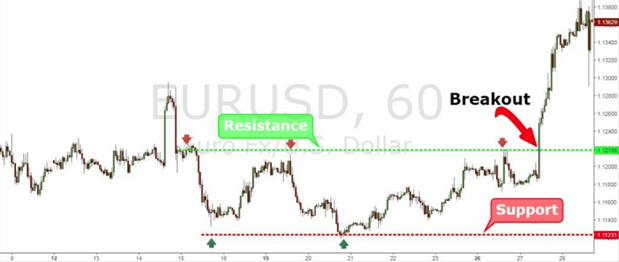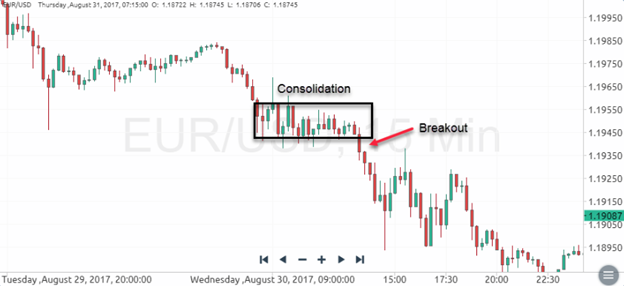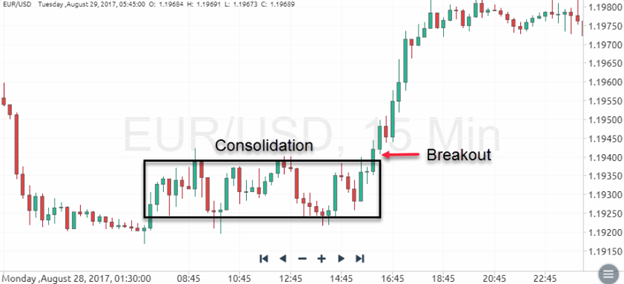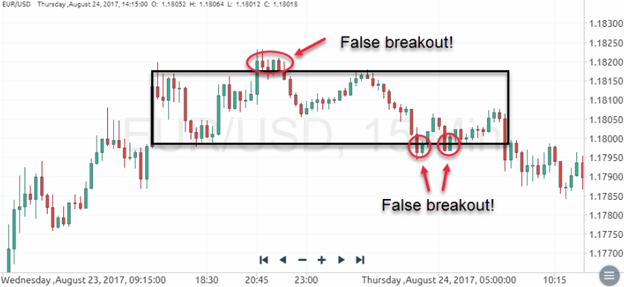-
TRADING
TRADING PLATFORM
Account type
Margin requirements
- TRADE RESOURCES
- INSTITUTIONAL SERVICE
- ABOUT
A breakout occurs when the price “breaks out” of some kind of consolidation or trading range.
A breakout can also occur when a specific price level is breached such as support and resistance levels, pivot points, Fibonacci levels, etc.
With breakout trades, the goal is to enter the market right when the price makes a breakout and then continue to ride the trade until volatility dies down.

When trading breakouts, it is important to consider the underlying stock's support and resistance levels. The more times a stock price has touched these areas, the more valid these levels are and the more important they become. At the same time, the longer these support and resistance levels have been in play, the better the outcome when the stock price finally breaks out
Volatility is something that we can use when looking for good breakout trade opportunities.
Volatility measures the overall price fluctuations over a certain time and this information can be used to detect potential breakouts.
There are a few indicators that can help you gauge a pair’s current volatility.
Using these indicators can help you tremendously when looking for breakout opportunities.
When trading breakouts in forex, it is important to realize that there are 3 main types:
1. Continuation breakouts
2. Reversal breakouts
3. False breakouts
Knowing what type of breakout you are seeing will help you make sense of what is actually happening in the big picture of the market.
Breakouts are significant because they indicate a change in the supply and demand of the currency pair you are trading.
This change in sentiment can cause extensive moves that provide excellent opportunities for you to grab some pips.
A continuation breakout is a breakout which continues in the same direction as the main trend. They occur after the price consolidates (range-bound market) after a significant move in price.
Continuation breakouts are situations where major players break out of trading ranges after periods of consolidation. Here traders take a breather after a long-protracted battle trying to jockey for trading position. Once they’ve caught their breath, the traders break out of the range – be it uptrend.
If traders decide that the initial trend was the right decision and continue to push the price in the same direction, the result is a continuation breakout. Just think of it as a “continuation” of the initial trend.

A reversal breakout, as the name suggests, reverses the previous trend in the opposite direction. In the beginning, it forms just like a continuation breakout, after the price consolidates after a big push in price.
Just like their brethren in continuation breakouts players also take a breather after locking horns with each other. However, there is a difference. The difference here is that the prevailing trend loses momentum after the players’ ability to sustain the trend begins to evaporate. consequently price is pushed in the opposite direction, resulting in a reversal breakout.
The only difference is that after this consolidation, forex traders decide that the trend is exhausted and push the price in the opposite or “reverse” direction.
As a result, you have what is called a “reversal breakout”.

A false breakout occurs when the price moves outside the consolidation range and closes outside but doesn’t continue in the direction of the breakout. Instead, the price moves back inside the consolidation range.

A good way to enter on a breakout is to wait until the price retraces back to the original breakout level and then wait to see if it bounces back to create a new high or low (depending on which direction you are trading).
Another way to combat fake outs is by not taking the first breakout you see.
By waiting to see if the price will continue to move in your intended direction, you give yourself a better chance of taking a profitable trade.
The downside to this is
that you may miss out on some trades in which the price moves quickly without
any hesitation.
Once you start getting used to the signs of breakouts, you’ll be able to spot good potential trades fairly quickly.
Chart Patterns can be well used: Double Top/Bottom; Head and Shoulders; Triple Top/Bottom
In addition to chart patterns, there are several tools and indicators you can use to supplement your case for a reversal breakout.
Beside trading breakouts out of consolidation phases, you can also use trendlines and channels to trade breakouts. By now, you already know what trendlines and channels are. When the price makes higher lows or lower highs, you can connect those price swings with a trendline and wait for the price to break out above or below the trendline. The following chart shows how to use trendlines when trading breakouts.
*The information presented above is intended for informative and educational purposes, should not be considered as investment advice, or an offer or solicitation for a transaction in any financial instrument and thus should not be treated as such. Past performance is not a reliable indicator of future results.

Online Chat Chat with us
Email:supportsohomarkets.cc
Copyright © 2024 - All rights reserved.
Soho Markets Global Limited is an Investment Firm incorporated under the laws of Republic of Mauritius under number 181778 and registered address at Suite 803, 8th Floor, Hennessy Tower, Pope Hennessy Street,11328, Port Louis, Mauritius. Regulated by the Financial Service Commission (FSC) in Mauritius under license number GB21026599.
RISK WARNING: Soho Markets Global Ltd offers trading on Foreign Exchange (‘Forex or ‘FX) and Contracts for Difference (‘CFDs), which are complex financial products that are traded on margin. They carry a high level of risk since leverage can work both to your advantage and disadvantage. As a result, these products may not be suitable for all investors, as loss of all invested capital may occur. You should not risk more than you are prepared to lose. Before deciding to trade, you need to ensure that you understand the risks involved and consider your investment objectives and level of experience. Seek independent advice, if necessary.
Soho Markets Global Ltd does not issue advice, recommendations or opinions in relation to acquiring, holding or disposing of a CFD.
Soho Markets Global Ltd is not a financial advisor and all services are provided on an execution-only basis. This communication is not an offer or solicitation to enter into a transaction and shall not be construed as such.
This website is not directed at any jurisdiction and is not intended for any use that would be contrary to local law or regulation.
By using our you agree to use our cookies to enhance your experience.
Services are not available for residents of Turkey and United States of America
Telephone: +230 2146398
CLIENT AGREEMENT (TERMS AND CONDITIONS) Complaints or Grievances Policy Conflicts of Interest Policy Cookie Policy Order Execution Policy Privacy Policy Risk Disclosure